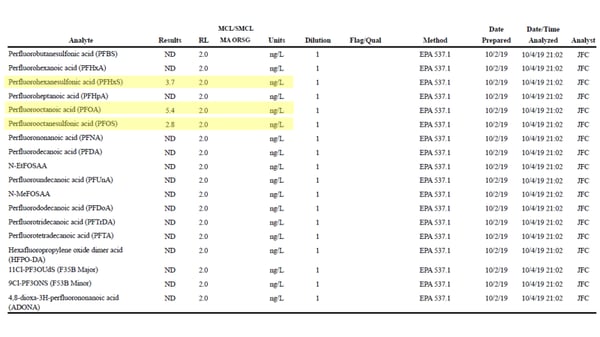 Per- and polyfluoroalkyl substances (PFAS) are a group of chemicals that have been manufactured and used in the United States since the 1940s. PFAS are commonly found in both household and industrial products such as non-stick coatings, stain and water repellent fabrics, and cleaning chemicals. Ground water contamination with PFAS has been associated with fire-fighting foams, manufacturing sites, landfills, and other industrial operations. Because of their chemical structure, PFAS are highly persistent in both the environment and human body. Studies have indicated that some PFAS compounds may be associated with adverse health effects, including:
Per- and polyfluoroalkyl substances (PFAS) are a group of chemicals that have been manufactured and used in the United States since the 1940s. PFAS are commonly found in both household and industrial products such as non-stick coatings, stain and water repellent fabrics, and cleaning chemicals. Ground water contamination with PFAS has been associated with fire-fighting foams, manufacturing sites, landfills, and other industrial operations. Because of their chemical structure, PFAS are highly persistent in both the environment and human body. Studies have indicated that some PFAS compounds may be associated with adverse health effects, including:
- Developmental effects to fetuses during pregnancy or to breastfed infants
- Immune system effects
- Liver and kidney effects
- Thyroid hormone disruption
- Increased cholesterol levels
- Increased risk of cancer
The U.S. Environmental Protection Agency (EPA) has issued a non-regulatory lifetime drinking water Health Advisory for PFAS for perfluorooctanoic acid (PFOA) and perfluorooctane sulfonate (PFOS), two of the most commonly studied PFAS chemicals. The EPA’s health advisory level of 70 parts per trillion (ppt) applies to the combined concentration of PFOA and PFOS in drinking water. There are currently no established state or federal regulatory limits for PFAS in drinking water, although the state of Massachusetts is currently considering a proposed 20 ppt threshold for six PFAS compounds.
A drinking water advisory was recently issued by my town’s school district due to PFAS contamination. Drinking water PFAS levels were measured at 24.5 ppt and 41.0 ppt in June of 2019 at the elementary school and co-located middle school. Both levels were below the U.S. EPA health advisory level and Massachusetts state guidelines. Despite the public guidelines, bottled water is currently being used at both schools since the levels exceeded the 20 ppt threshold currently under consideration by the Massachusetts Department of Environmental Protection (DEP). As the father of a five-year-old and five-week-old child, I recently tested my water supply and found a combined level of 11.9 ppt for three PFAS compounds (see test results below). A map of PFAS testing results and locations is provided on the MassDEP website.
This scenario exemplifies the major differences in position and acceptable risk among federal, state, and local authorities and the general public. It also highlights the need for additional research to development a consistent regulatory approach and standards among all entities.

Dr. Michael P. Mellette is a Certified Industrial Hygienist (CIH) with more than 15 years of environmental health and safety experience. His practice area focuses on complex exposure assessments related to environmental health, occupational exposures, indoor air quality, mold and Legionella. His past roles and project work have focused on industrial hygiene/exposure assessment, regulated building materials (asbestos, lead, PCBs), occupational safety, the transportation of hazardous materials, and environmental compliance.
Contact CCA today for help with environmental health or occupational exposure related issues, or for insurance claim or expert litigation support.
Recent Peer-Reviewed Papers:
Mellette, Michael P., Dhimiter Bello, Yalong Xue, Michael Yost, Anila Bello, and Susan Woskie. 2018. "Testing of Disposable Protective Garments Against Isocyanate Permeation From Spray Polyurethane Foam Insulation." Annals of Work Exposures and Health 62(6):754–64.
Mellette, Michael P., Dhimiter Bello, Yalong Xue, Michael Yost, Anila Bello, and Susan Woskie. 2019. "Evaluation of Disposable Protective Garments against Isocyanate Permeation and Penetration from Polyurethane Anticorrosion Coatings." Annals of Work Exposures and Health 63(5):592–603.
References
U.S. EPA. n.d. "Basic Information on PFAS.” Washington, DC: U.S. Environmental Protection Agency.
U.S. EPA. 2016. "Drinking Water Health Advisory for Perfluorooctanoic Acid (PFOA).” EPA 822-R-16-005. Washington, DC: U.S. Environmental Protection Agency."
U.S. EPA. 2016. "Drinking Water Health Advisory for Perfluorooctane Sulfonate (PFOS).” EPA 822-R-16-004. Washington, DC: U.S. Environmental Protection Agency."
U.S. ATSDR. 2018. "Per- and Polyfluoroalkyl Substances (PFAS) and Your Health" Atlanta, GA: Agency for Toxic Substances and Disease Registry.
MassDEP. n.d. "Per- and Polyfluoroalkyl Substances (PFAS)”. Boston, MA: Massachusetts Department of Environmental Protection."


